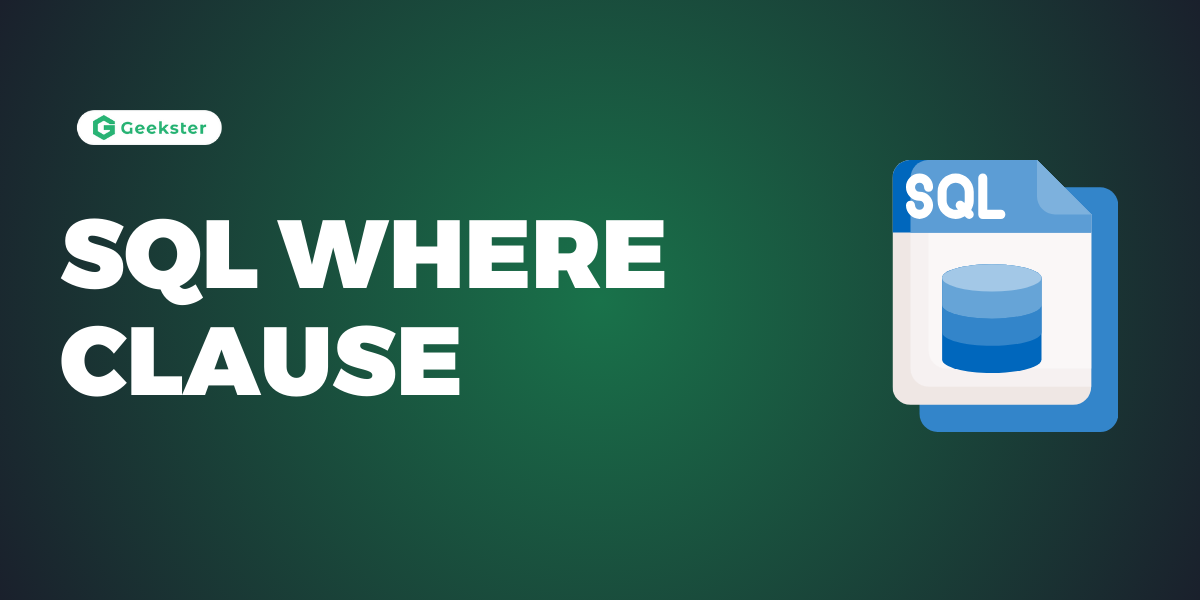Imagine a giant warehouse full of boxes. You only want the boxes with red shoes. The WHERE clause in SQL acts like a magical filter. You tell it “red shoes,” and it sifts through everything, grabbing only boxes with red shoes and leaving the rest behind.
That’s what WHERE does in databases! It lets you search for specific information. You can tell it things like “find emails from John” or “show me customers who live in California.” By narrowing down your search, you get exactly what you need, faster and easier. It’s like a super-powered search function for giant databases!
WHERE keyword is used for fetching filtered data in a result set, it is used to fetch data according to particular criteria, WHERE keyword can also be used to filter data by matching patterns.
Syntax
SELECT column1, column2, ...
FROM table_name
WHERE condition;Operators in the WHERE Clause
Operators in the WHERE clause in SQL help you to specify the various conditions that you would like to query from a database.
Here is a list of popular operators that are used in WHERE to select desired columns for a record.
| Operator | Description |
| = | Equals |
| > | Greater than |
| < | Less than |
| >= | Greater than or equal |
| <= | Less than or equal |
| <> or != | Not equal |
| BETWEEN | Between a certain specified range |
| LIKE | Searching for a pattern |
| IN | To specify multiple possible values for a column |
Examples of WHERE CLAUSE
Example 1
-- Creating the table
CREATE TABLE students (
student_id INT PRIMARY KEY,
name VARCHAR(50),
age INT
);
-- Inserting sample data
INSERT INTO students (student_id, name, age) VALUES
(1, 'Alice', 18),
(2, 'Bob', 22),
(3, 'Charlie', 20),
(4, 'David', 25),
(5, 'Emily', 19);
-- Query using WHERE clause with greater than operator
SELECT name
FROM students
WHERE age > 20;
Output
| name |
|----------|
| Bob |
| David |
Example 2
-- Creating the table
CREATE TABLE products (
product_id INT PRIMARY KEY,
name VARCHAR(50),
price DECIMAL(10, 2)
);
-- Inserting sample data
INSERT INTO products (product_id, name, price) VALUES
(1, 'Laptop', 799.99),
(2, 'Phone', 499.99),
(3, 'Headphones', 29.99),
(4, 'Keyboard', 39.99),
(5, 'Mouse', 19.99);
-- Query using WHERE clause with less than or equal to operator
SELECT name
FROM products
WHERE price <= 50.00;
Output
| name |
|--------------|
| Headphones |
| Keyboard |
| Mouse |
Example 3
-- Creating the table
CREATE TABLE employees (
employee_id INT PRIMARY KEY,
name VARCHAR(50),
department VARCHAR(50)
);
-- Inserting sample data
INSERT INTO employees (employee_id, name, department) VALUES
(1, 'John', 'Sales'),
(2, 'Emily', 'Marketing'),
(3, 'Michael', 'Sales'),
(4, 'Sarah', 'HR'),
(5, 'David', 'Sales');
-- Query using WHERE clause with equal to operator
SELECT name
FROM employees
WHERE department = 'Sales';
Output
| name |
|----------|
| John |
| Michael |
| David |Conclusion
The SQL WHERE clause serves as a powerful tool for filtering data from database tables based on specified conditions. Through its flexibility and versatility, the WHERE clause enables users to retrieve precisely the information they need, thereby enhancing the efficiency and effectiveness of database queries. By incorporating various logical and comparison operators such as equals, greater than, less than, and many more, the WHERE clause allows for complex filtering criteria to be applied, catering to a wide range of querying requirements.
In conclusion, the SQL WHERE clause plays a crucial role in data manipulation and analysis, empowering users to extract meaningful insights from large datasets while minimizing unnecessary data retrieval. Whether it’s selecting employees from a specific department, finding products within a certain price range, or identifying students based on their age, the WHERE clause provides the necessary mechanism to tailor query results to meet specific criteria, ultimately facilitating informed decision-making and deeper exploration of the underlying data.
Frequently Asked Questions
The SQL WHERE clause filters rows from a table based on specified conditions. Developers commonly use it in SELECT, UPDATE, DELETE, and other SQL statements to retrieve, modify, or remove data that meets certain criteria.
Basic operators used with the WHERE clause include equals (=), not equals (!= or <>), greater than (>), less than (<), greater than or equal to (>=), and less than or equal to (<=). These operators are used to create conditions for filtering data.
Yes, multiple conditions can be combined in a WHERE clause using logical operators such as AND, OR, and NOT. This allows for more complex filtering conditions to be applied, such as selecting rows that meet multiple criteria simultaneously.
Yes, wildcards such as ‘%’ and ‘_’ can be used in conjunction with the LIKE operator in the WHERE clause to perform pattern matching on string values. This enables flexible searching for values that partially match specified patterns.
Yes, SQL functions can be used within the WHERE clause to manipulate or evaluate data before applying filtering conditions. Common functions include mathematical functions, date functions, string functions, and aggregate functions.

